5 Best AI Stocks to Buy Today
| Company (Ticker) | 12 Week Price Change | Forward PE | Price | Proj EPS Growth (1 Year) | Projected Sales Growth (1Y) |
|---|---|---|---|---|---|
| Micron Technology (MU) | 81.90% | 12.20 | $202.38 | 100.01% | 42.51% |
| Dell Technologies (DELL) | 14.00% | 15.68 | $149.59 | 17.24% | 11.85% |
| Analog Devices (ADI) | 6.61% | 31.33 | $242.87 | 21.50% | 16.20% |
| ServiceNow (NOW) | -6.73% | 53.73 | $903.60 | 20.82% | 19.77% |
| Meta Platforms (META) | 0.59% | 25.47 | $716.92 | 17.97% | 19.07% |
*Updated on October 19, 2025.
Stock #1
Micron Technology (MU)
$202.38 USD -0.15 (-0.07%)
3-Year Stock Price Performance
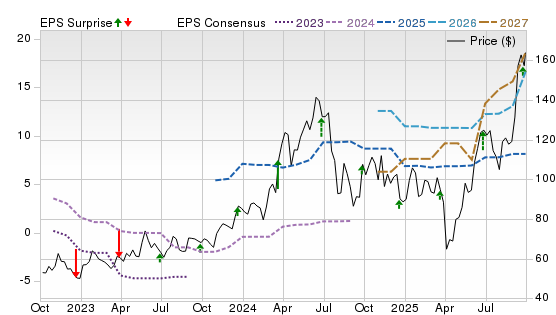
Premium Research for MU
- Zacks Rank
- Strong Buy 1
- Style Scores
B Value A Growth C Momentum A VGM
- Market Cap: $209.97B (Large Cap)
- Projected EPS Growth:100.00%
- Last Quarter EPS Growth:65.32%
- Last EPS Surprise:5.94%
- Next EPS Report date:Dec. 17, 2025
Our Take:
Micron manufactures Dynamic Random Access Memory (DRAM), NAND, and high-bandwidth memory that power AI training and inference. Last year, the company began volume production of HBM3E for Nvidia’s H200 and has since moved aggressively on next-gen HBM, underscoring its importance in AI accelerators.
Its Zacks Rank #1 (Strong Buy) reflects rising earnings estimates, while its Style Scores show a balanced profile, with B for Value, A for Growth, D for Momentum, and a VGM Score of A. This suggests attractive fundamentals even as near-term price momentum lags. Fundamentally, Micron is benefiting from tightening memory supply and surging AI server demand that supports pricing and margins.
The Price, Consensus & EPS Surprise chart shows the stock trending higher alongside a notable upturn in out-year EPS consensus, with recent surprises skewing positive, which is consistent with estimate momentum backing the Rank.
Stock #2
Dell Technologies (DELL)
$149.59 USD -1.72 (-1.14%)
3-Year Stock Price Performance
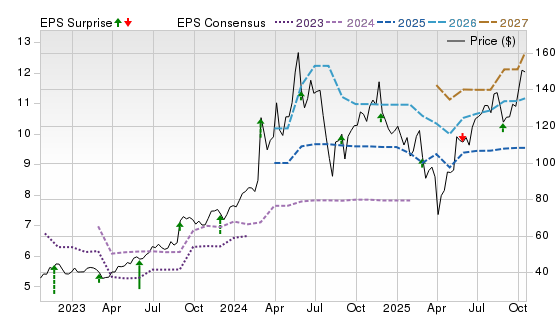
Premium Research for DELL
- Zacks Rank
 Strong Buy 1
Strong Buy 1
- Style Scores
B Value C Growth C Momentum B VGM
- Market Cap:$100.03B (Large Cap)
- Projected EPS Growth:17.20%
- Last Quarter EPS Growth:48.94%
- Last EPS Surprise:0.43%
- Next EPS Report date:Nov. 25, 2025
Our Take:
Dell builds and integrates AI infrastructure, spanning GPU-dense PowerEdge servers to turnkey “AI Factory” solutions, positioning the company as a key on-ramp for enterprises deploying AI. The stock’s Zacks Rank #1 and Style Scores of B for Value, C for Growth and Momentum, and a VGM Score of B indicate supportive estimates and reasonable valuation despite uneven recent momentum.
Strategically, Dell is broadening its NVIDIA-based lineup, including Blackwell-class systems with liquid-cooling options, and has raised its growth outlook as AI server demand accelerates. These moves deepen exposure to training and inference build-outs across cloud and enterprise customers.
On the chart, the price has recovered from mid-cycle volatility as the 2026–2027 EPS tracks higher, signaling healthy estimate revisions in step with the AI server backlog. While component availability poses some execution risk, the improving consensus trend and Rank indicate a favorable backdrop as shipments scale.
Stock #3
Analog Devices (ADI)
$242.87 USD +1.26 (0.52%)
3-Year Stock Price Performance
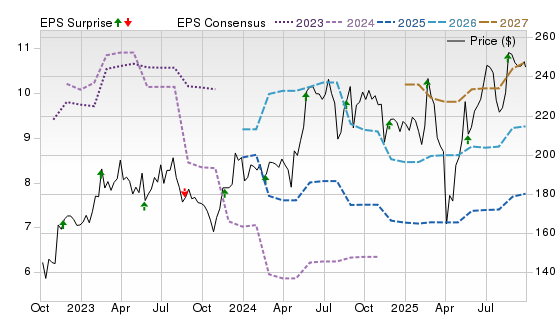
Premium Research for ADI
- Zacks Rank
 Strong Buy 1
Strong Buy 1
- Style Scores
D Value F Growth D Momentum F VGM
- Market Cap:$115.81B (Large Cap)
- Projected EPS Growth:21.47%
- Last Quarter EPS Growth: 10.81%
- Last EPS Surprise:6.22%
- Next EPS Report date:Nov. 25, 2025
Our Take:
Analog Devices supplies power, signal-chain, and mixed-signal chips used across AI “factories,” including new solutions for 800-V data-center architectures aimed at higher efficiency and safer distribution.
The stock’s Zacks Rank #1 offsets mixed Style Scores, with D for Value and Growth, C for Momentum, and a VGM Score of F, implying estimate support even with a premium valuation profile. However, strong Momentum suggests improving sentiment as AI power needs escalate. ADI’s portfolio of industrial sensors, connectivity, and processing solutions offers steady growth potential across markets, providing diversification well beyond data centers.
The chart depicts a constructive uptrend with price strength coinciding with steadily improving out-year EPS estimates, reflecting traction in data-center and industrial demand. That setup points to early-stage earnings rebuild as AI power delivery and edge automation demand begin to flow through orders.
Stock #4
ServiceNow (NOW)
$903.60 USD +9.11 (1.02%)
3-Year Stock Price Performance
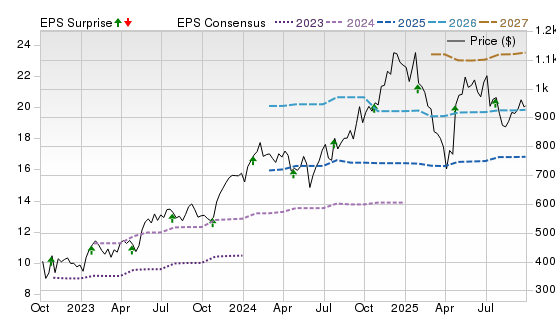
Premium Research for NOW
- Zacks Rank
 Buy 2
Buy 2
- Style Scores
F Value B Growth F Momentum D VGM
- Market Cap:$189.54B (Large Cap)
- Projected EPS Growth:20.76%
- Last Quarter EPS Growth:-4.76%
- Last EPS Surprise: 15.54%
- Next EPS Report date:Oct. 29, 2025
Our Take:
ServiceNow embeds generative AI across its workflow platform through Now Assist and is expanding partnerships, most notably with NVIDIA, to co-develop domain-specific AI agents that can be integrated within existing workflows. ServiceNow has been benefiting from the rising adoption of workflows by enterprises undergoing digital transformation.
It has a Zacks Rank #2 (Buy) and Style Scores of F for Value, B for Growth, F for Momentum, and a VGM Score of D. These point to estimate support, but a rich multiple and choppy momentum, reflecting recent volatility despite AI deal traction and optimism tied to GenAI demand.
On the chart, out-year EPS estimates have trended higher even as the stock has been volatile, a pattern consistent with premium software multiples during investment cycles. That pattern supports a constructive view as AI features widen adoption and usage-based monetization ramps.
Stock #5
Meta Platforms (META)
$716.92 USD +4.85 (0.68%)
3-Year Stock Price Performance
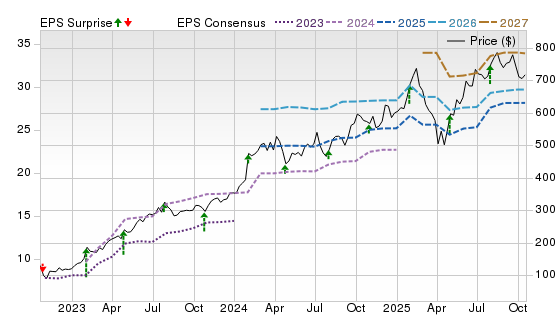
Premium Research for META
- Zacks Rank
 Buy 2
Buy 2
- Style Scores
C Value B Growth B Momentum B VGM
- Market Cap: $1,780.23B (Large Cap)
- Projected EPS Growth:17.98%
- Last Quarter EPS Growth: 11.04%
- Last EPS Surprise:22.47%
- Next EPS Report date:Oct. 29, 2025
Our Take:
Meta operates social platforms like FaceBook and Instagram and is investing heavily to build end-to-end AI capabilities—from Llama models and Meta AI assistants to custom inference silicon (MTIA). Its elevated capex for data centers and Graphics Processing Units (GPUs) is aimed at deepening AI advantages across ranking and ads, assistants, and creator tools, supporting monetization over time.
Meta has a Zacks Rank #2 with Style Scores of C for Value, B for Growth and Momentum, and a VGM Score of B. This signals a solid quantitative setup supported by estimate revisions and constructive momentum.
The chart shows shares consolidating after a strong run, while 2026–2027 EPS estimates remain firm to higher. This signals confidence that aggressive AI spending will translate into durable earnings power as models and services scale.
Methodology
The Zacks Rank is a proprietary stock-rating model that uses trends in earnings estimate revisions and earnings-per-share (EPS) surprises to classify stocks into five groups: #1 (Strong Buy), #2 (Buy), #3 (Hold), #4 (Sell) and #5 (Strong Sell). The Zacks Rank is calculated through four primary factors related to earnings estimates: analysts' consensus on earnings estimate revisions, the magnitude of revision change, the upside potential and estimate surprise (or the degree in which earnings per share deviated from the previous quarter).
Zacks builds the data from 3,000 analysts at over 150 different brokerage firms. The average yearly gain for Zacks Rank #1 (Strong Buy) stocks is +23.62% per year from January, 1988, through June 2, 2025.
Selections for Best AI Stocks are based on the current top ranking stocks based on Zacks Indicator Score. For this list, only companies that have average daily trading volumes of 100,000 shares or more and at least five analysts covering the stock were considered. All information is current as of market open, Oct. 15, 2025.
Guide to AI Stocks
The classification of “AI Stocks” is actually quite broad, ranging from companies that provide the essential hardware, companies that create the software to run Large Language Models, and a whole host of other industries and companies that are creating the Artificial Intelligence ecosystem. All stand to gain – or lose – depending on the fortunes of AI tech.
Types of AI Stocks
Hardware (GPUs, Chips) Stocks – NVIDIA, AMD, TSMC, Broadcom
The backbone of AI is raw computing power, and this comes primarily from specialized chips like graphics processing units (GPUs) and AI-focused accelerators. NVIDIA (NVDA) is the undisputed leader in GPUs used for training large language models.
Advanced Micro Devices (AMD) is a rising competitor, with its MI300 series targeting data center AI workloads. Taiwan Semiconductor Manufacturing Co. (TSMC) doesn’t make its own chips but manufactures advanced nodes for nearly every big tech firm—including Apple, Nvidia, and AMD—making it critical to the global AI supply chain. Broadcom (AVGO) has carved a niche in custom ASICs (application-specific integrated circuits) for hyperscale cloud providers, which value tailored chips that reduce energy use and maximize throughput.
These companies benefit from structural demand for more computing capacity, but they also face geopolitical risks such as U.S.-China export restrictions and cyclical swings in semiconductor demand.
AI Cloud & Infrastructure – Microsoft, Amazon, Alphabet
Building AI applications at scale requires massive computing infrastructure. Azure from Microsoft (MSFT) has become a leader by integrating OpenAI’s models directly into its cloud offerings, giving it a first-mover advantage in AI enterprise adoption. Amazon Web Services, a subsidiary of Amazon (AMZN) is deploying its in-house Trainium and Inferentia chips, aiming to lower costs for AI workloads while retaining dominance in cloud services. Alphabet’s (GOOG) Google Cloud is leaning heavily on its proprietary Tensor Processing Units (TPUs) and Gemini AI models to differentiate itself.
Investing in these players is less about speculative growth and more about diversified tech giants whose AI investments bolster an already profitable core business.
Enterprise AI Software & Analytics – Palantir, C3.ai, Adobe, Snowflake
AI isn’t just about hardware; software platforms are where businesses actually apply machine intelligence. Palantir (PLTR) powers decision-making for defense and large corporations with its Foundry and Gotham platforms. C3.ai (AI) focuses specifically on AI-driven applications across industries like energy, finance, and manufacturing. Adobe (ADBE) has integrated AI across its creative suite (e.g., Firefly in Photoshop), while Snowflake (SNOW) has added AI-enabled analytics to its cloud data warehousing business.
These stocks tend to have higher growth potential but also higher risk, as adoption timelines and customer budgets can vary widely.
Cybersecurity AI – CrowdStrike
The rise of AI also heightens cyber risks. CrowdStrike (CRWD) leads in AI-powered threat detection, using machine learning to flag suspicious behavior across millions of endpoints in real time. With ransomware and nation-state attacks increasing, demand for AI-driven security remains strong. Cybersecurity names often benefit from recurring revenue models, which may help smooth out volatility compared to hardware peers.
Benefits and Risks of AI Stocks
Benefits:
- Secular Growth: AI adoption is still in early innings, with enterprise use cases expanding rapidly.
- Diversified Exposure: Investors can target infrastructure, software, or services depending on risk tolerance.
- First-Mover Advantage: Leaders like NVIDIA and Microsoft are shaping the ecosystem, creating strong economic moats.
Risks:
- Valuations: Many AI leaders are priced for perfection, leaving little margin of safety.
- Hype Cycle: Investor enthusiasm may outrun near-term fundamentals, creating bubble risk.
- Regulation: Governments are exploring AI rules around privacy, bias, and national security, which could reshape business models.
- Competition: Barriers to entry are high, but fast innovation means today’s leader can quickly lose ground.
How to Choose AI Stocks
When evaluating AI stocks, consider:
- Revenue Mix: How much of the company’s growth is truly driven by AI vs. traditional segments?
- Moat & Differentiation: Does the company control unique technology (like NVIDIA’s CUDA software ecosystem)?
- Customer Adoption: Look for companies with recurring contracts or wide adoption across industries.
- Financial Health: Strong balance sheets matter in a capital-intensive industry.
- Valuation Metrics: Compare price-to-earnings (P/E) ratio, price-to-sales (P/S) ratio, and forward growth projections to industry peers.
How to Invest in AI Stocks
There are multiple entry points depending on your goals:
- Direct Stock Picks: Best if you want concentrated exposure to specific company leaders or disruptors.
- AI Exchange-Traded Funds (ETFs): ETFs such as Global X Robotics & Artificial Intelligence ETF (BOTZ) or iShares Robotics and AI ETF (IRBO) provide diversification by investing in a broad range of companies in the AI space.
- Broad Tech ETFs: Like Invesco QQQ (QQQ) or Vanguard Information Technology ETF (VGT), offering AI exposure as part of a bigger tech basket.
- Dollar-Cost Averaging (DCA): A strategy to smooth price volatility by buying at regular intervals AI stocks or funds.
- Long-Term Holds: Since AI is a multi-decade trend, investors who can weather short-term swings may see the best results.
AI Stocks Alternatives
If you want exposure to AI without betting on a single stock:
- ETFs: Offer diversification and reduce single-company risk.
- Private Markets: Startups in robotics, generative AI, and enterprise AI could offer upside, though access is limited to accredited investors, which face income or licensing limitations (such as a net worth of $1 million, excluding primary residence, plus a high annual income – $300,000 if married.
- Picks-and-Shovels Plays: Companies supplying infrastructure, like power management (e.g., Eaton) or data center REITs (e.g., Equinix), benefit indirectly from AI growth.
Strategies for AI Stocks Moving Forward
- Barbell Approach: Combine stable mega-caps (Microsoft, Nvidia) with speculative names (Quantum Computing Inc., Credo) for balanced exposure.
- Rebalancing: Trim positions after strong rallies to lock in gains and redeploy into underweighted sectors.
- Monitor Earnings: Focus on whether AI adoption translates into sustainable revenue growth.
- Look Beyond the U.S.: Consider emerging AI leaders in Europe and Asia for diversification.
- Stay Agile: AI is evolving rapidly; reassess holdings every quarter as new winners emerge.
Frequently Asked Questions About AI Stocks
Are AI stocks overvalued?
Many AI leaders are priced at steep multiples compared to the broader market. That doesn’t mean all are bubbles, but investors should separate hype from earnings-driven growth.
What is the forecast for AI stocks?
Most analysts expect AI demand to expand through at least the next decade, with data center spending, AI-as-a-service, and AI-enabled enterprise tools driving revenue.
What metrics best signal AI efficacy?
- Growth in AI-specific revenue lines.
- Gross margin improvements tied to AI.
- Customer retention and expansion.
- Evidence of scale: Contracts, partnerships, recurring revenue.














